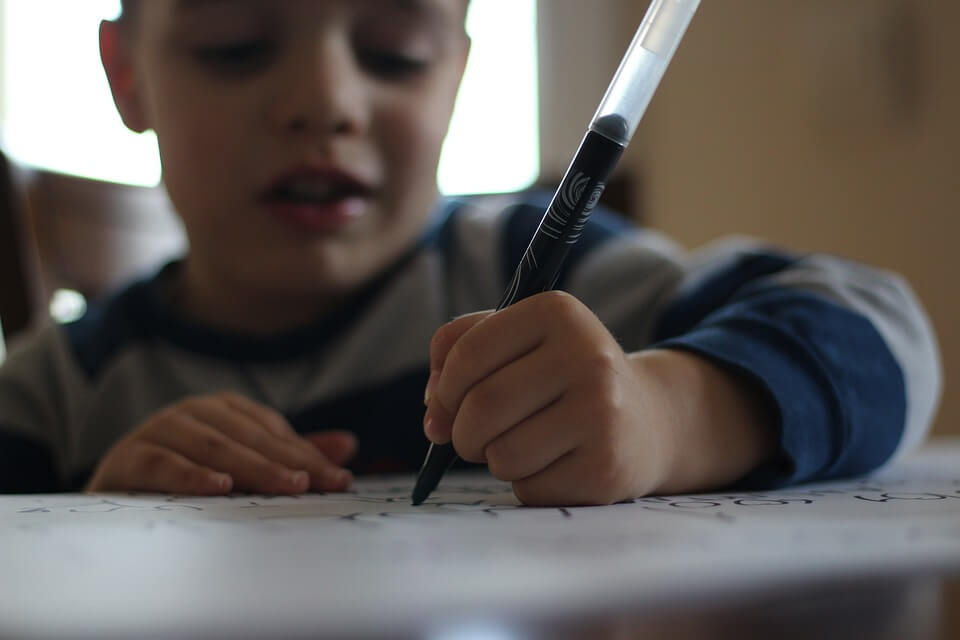Improve Your Child's Handwriting with These Fun Games


Reviewed and approved by the psychologist María Alejandra Castro Arbeláez
Handwriting is a skill that can be improved. Just spend a few hours a day practicing it. If your purpose is to help your child achieve handwriting that is beautiful and readable, this article will help you do so.
Improve finger strength
For good handwriting, your child’s fingers must be stronger. Keep in mind that the fingers hold the pencil, and much of the movement made when writing is done precisely through them.
For this goal, we recommend buying plasticine to cut and shape at will.
Give your child sheets of paper and teach him to tear. It’s not necessarily important to follow the lines, but rather to hold the paper well and to rip using the thumb and forefinger.
Give him crayons, colored pencils, watercolors and paint brushes. Your child needs to practice with pencils and brushes in order to master them, and he’ll be strengthening his still-weak little fingers, performing exercises that will help improve handwriting.
Supervise your child so that he does all the games and their movements correctly. This is also a good excuse to hang out together, while learning and being entertained.
Teach him to play music on the piano using the hand mainly used for writing. Or if you prefer, show him how to strum the strings of a guitar.

Offer him scissors to cut with. The scissors are held with the thumb and forefinger, which as we know play an important role in handwriting.
Let him type on the computer keyboard. Although children need to write more by hand and to use keyboards less, in the beginning when he is just learning to write, keyboards can help him gain agility and mastery with his fingers.
Stroke Games to Improve Handwriting
Making strokes over and over in a sequence is the best way to get your child to learn to write well. Therefore, we encourage you to have your child draw strokes at least one hour per day.
Show him, for example, how to make spirals, then to make them bigger, smaller, with more or less twists, in colors … remember that the practice needs to be a little fun to make it more attractive.
Try sketching one of his favorite characters using single dots. For example, if your child likes Mickey Mouse, look for a drawing of him; place it on a white sheet of paper and outline his main features. We suggest you mark dots within a reasonable distance.
When the dotted outline of Micky Mouse is sketched, ask your child to mark it by joining the points and without lifting the pencil. This is an excellent and fun exercise to take control of the strokes and improve handwriting.
Another recommended activity for handwriting is to give your child a lined notebook and teach him how to draw repetitive shapes without lifting the pencil, such as squares, ovals, stars, etc.
Give him the freedom to make strokes at will. Surely, when he was younger, your child loved writing on the walls or any other surface that was placed in front of him.
Well, this may be a good time to allow him to draw in places you haven’t let him before… within reason, of course. Give him colored chalks, for example, and allow him to draw on the sidewalk in front of your house or garage.

Improve your child’s handwriting with these fun games
To improve your child’s handwriting, it’s also important that you take the time to teach him how to draw all the letters he is learning at school.
To motivate him, you can reward them with a star or praise them when they do their best.
Remember, when your child is writing, he or she should sit correctly: back straight and glued to the chair, one hand holding the sheet of paper and the other with their elbow resting on the table. No “lying down” on the paper or hunching over, because that poor posture will affect his or her handwriting.
Handwriting is a skill that can be improved. Just spend a few hours a day practicing it. If your purpose is to help your child achieve handwriting that is beautiful and readable, this article will help you do so.
Improve finger strength
For good handwriting, your child’s fingers must be stronger. Keep in mind that the fingers hold the pencil, and much of the movement made when writing is done precisely through them.
For this goal, we recommend buying plasticine to cut and shape at will.
Give your child sheets of paper and teach him to tear. It’s not necessarily important to follow the lines, but rather to hold the paper well and to rip using the thumb and forefinger.
Give him crayons, colored pencils, watercolors and paint brushes. Your child needs to practice with pencils and brushes in order to master them, and he’ll be strengthening his still-weak little fingers, performing exercises that will help improve handwriting.
Supervise your child so that he does all the games and their movements correctly. This is also a good excuse to hang out together, while learning and being entertained.
Teach him to play music on the piano using the hand mainly used for writing. Or if you prefer, show him how to strum the strings of a guitar.

Offer him scissors to cut with. The scissors are held with the thumb and forefinger, which as we know play an important role in handwriting.
Let him type on the computer keyboard. Although children need to write more by hand and to use keyboards less, in the beginning when he is just learning to write, keyboards can help him gain agility and mastery with his fingers.
Stroke Games to Improve Handwriting
Making strokes over and over in a sequence is the best way to get your child to learn to write well. Therefore, we encourage you to have your child draw strokes at least one hour per day.
Show him, for example, how to make spirals, then to make them bigger, smaller, with more or less twists, in colors … remember that the practice needs to be a little fun to make it more attractive.
Try sketching one of his favorite characters using single dots. For example, if your child likes Mickey Mouse, look for a drawing of him; place it on a white sheet of paper and outline his main features. We suggest you mark dots within a reasonable distance.
When the dotted outline of Micky Mouse is sketched, ask your child to mark it by joining the points and without lifting the pencil. This is an excellent and fun exercise to take control of the strokes and improve handwriting.
Another recommended activity for handwriting is to give your child a lined notebook and teach him how to draw repetitive shapes without lifting the pencil, such as squares, ovals, stars, etc.
Give him the freedom to make strokes at will. Surely, when he was younger, your child loved writing on the walls or any other surface that was placed in front of him.
Well, this may be a good time to allow him to draw in places you haven’t let him before… within reason, of course. Give him colored chalks, for example, and allow him to draw on the sidewalk in front of your house or garage.

Improve your child’s handwriting with these fun games
To improve your child’s handwriting, it’s also important that you take the time to teach him how to draw all the letters he is learning at school.
To motivate him, you can reward them with a star or praise them when they do their best.
Remember, when your child is writing, he or she should sit correctly: back straight and glued to the chair, one hand holding the sheet of paper and the other with their elbow resting on the table. No “lying down” on the paper or hunching over, because that poor posture will affect his or her handwriting.
All cited sources were thoroughly reviewed by our team to ensure their quality, reliability, currency, and validity. The bibliography of this article was considered reliable and of academic or scientific accuracy.
- Bravo, P. M., & Jorge, C. M. H. (2010). Mejorar la caligrafía de niños y niñas con altas capacidades intelectuales con un programa de reforzamiento. In Motivación y emoción: investigaciones actuales (pp. 383-392). Servicio de Publicaciones.
- Fons, M. (2001). Enseñar a leer y a escribir. En Didáctica de la lengua en la educación infantil. Monserrat, Bigas y Monserrat Correig (Edits.) pp. 179-212. Madrid: SÍNTESIS, S. A.
- Gómez, L. F. (2007). Caligrafía y legibilidad. Correo del Maestro, (131).
- Peña, J. (2010). Exploración sobre la experiencia en escritura de niños de la primera etapa de educación básica. Legenda, 13(10), 164-181. http://erevistas.saber.ula.ve/index.php/legenda/article/viewFile/613/754
- Villalobos, J. (2006). La lectura y la escritura como herramientas para el desarrollo del cono-cimiento y aprendizaje. En J. Peña González y S. Serrano de Moreno (Comps.), La lectura y la escritura. Teoría y práctica (pp. 33-58). Mérida. Venezuela: Consejo de Desarrollo Científico Humanístico y Tecnológico y Consejo de Estudios de Postgrado Universidad de Los Andes.
This text is provided for informational purposes only and does not replace consultation with a professional. If in doubt, consult your specialist.








